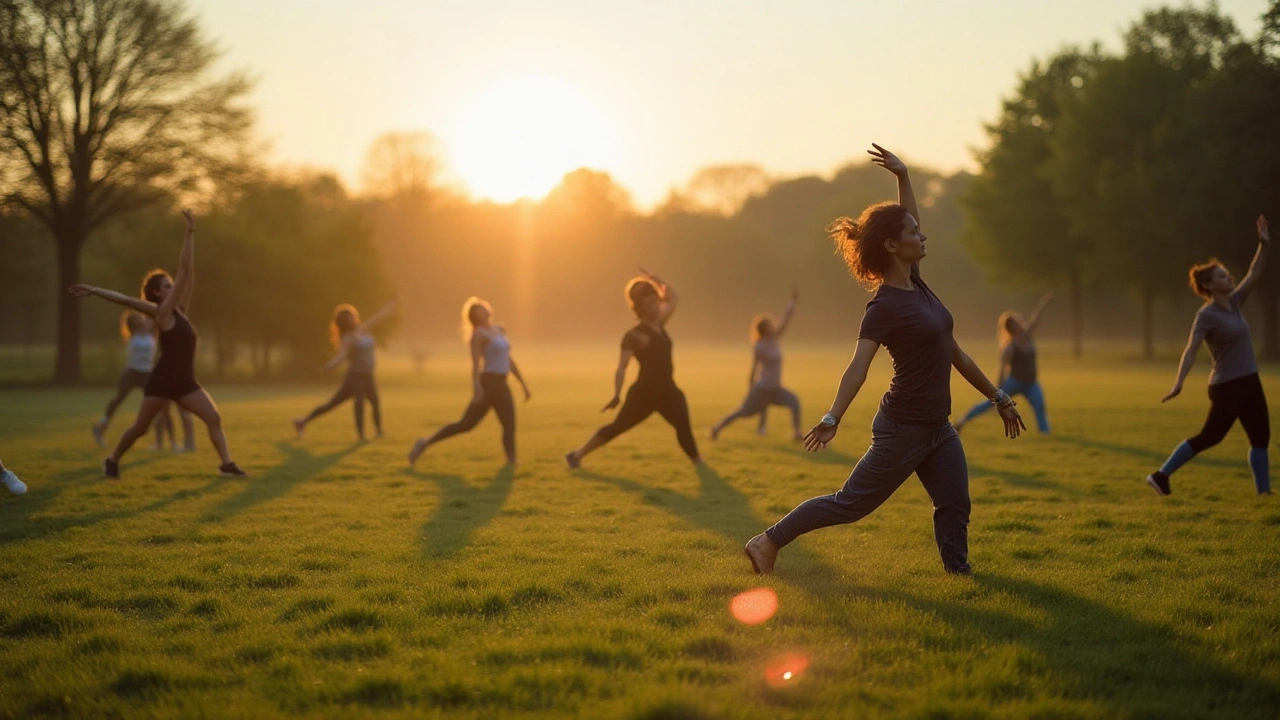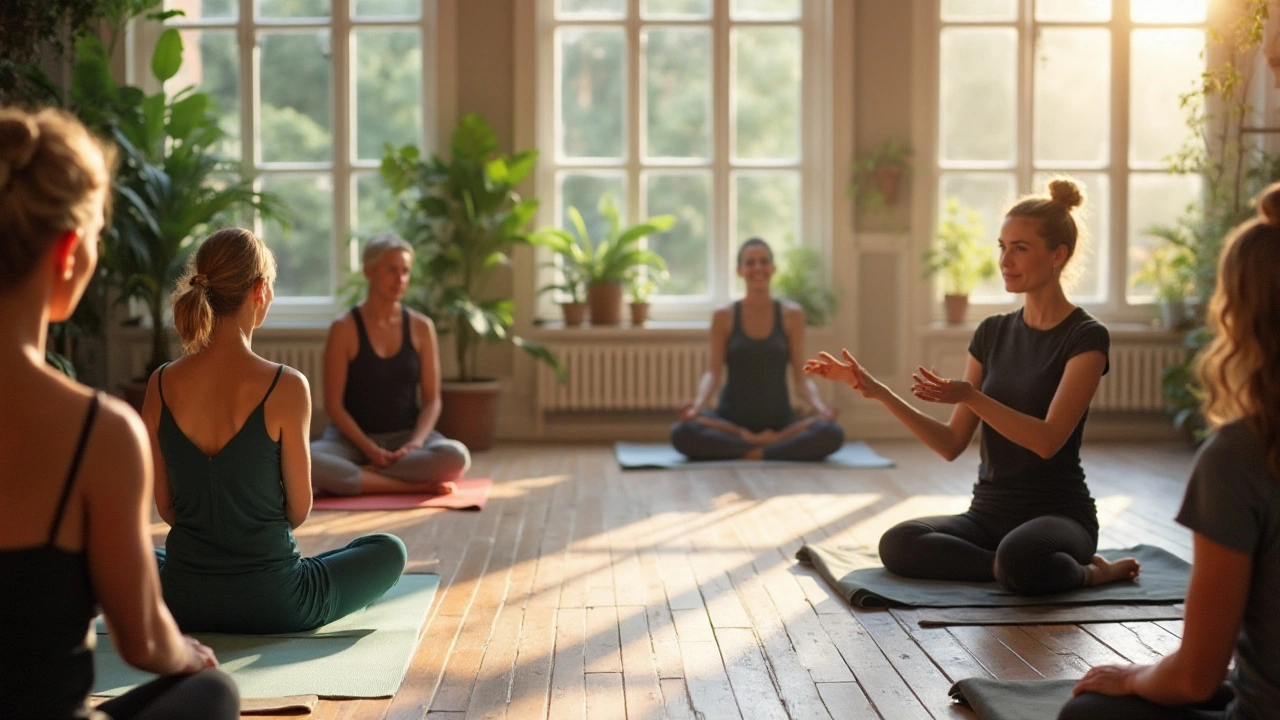Unlocking Body Potential through Feldenkrais Method
 Oct, 7 2024
Oct, 7 2024
The Feldenkrais Method remains one of the hidden jewels of mind-body practices. With its roots in enhancing movement through awareness, it offers a gentle yet powerful way to improve how the body functions. Unlike other physical exercises, it delves into the connection between the brain and movement, promoting harmony within oneself.
People have long been searching for ways to get relief from chronic pain and improve their quality of movement. Whether you are a dancer, athlete, or someone simply wanting to move with more ease, Feldenkrais Training can offer valuable insight. It's about moving smarter, not harder, using thoughtful exploration to build resilience and agility.
- Understanding the Feldenkrais Method
- Benefits of Feldenkrais Training
- Practical Applications in Daily Life
- Tips for Beginners
- Finding a Qualified Instructor
Understanding the Feldenkrais Method
The Feldenkrais Method is a unique approach developed by Moshe Feldenkrais, a physicist and engineer who sought to heal his own injury through understanding movement. The core principle of this method is the belief that by increasing one's awareness of movement, one can improve the efficiency and ease of motion. Rather than pushing the body through rigorous or repetitive exercises, this method invites individuals to explore gentle, mindful movements that enhance the natural functioning of the body.
One of the distinguishing features of the Feldenkrais Method is its compassionate approach to training the mind and body. Unlike traditional exercises where repetition is key, this method focuses on variations and attention to detail. It involves a series of structured yet adaptable movement sequences called Awareness Through Movement (ATM) lessons. These are typically done in a group setting, where verbal instructions guide participants through movements. Functional Integration (FI), on the other hand, is a hands-on approach, often delivered in a one-on-one session where the practitioner uses touch to guide the individual's movements.
An essential aspect of Feldenkrais Training is its adaptability to each person's needs and limitations. Whether dealing with sports injuries or neurological conditions, this method encourages small adjustments based on feedback from the body, which in turn fosters more efficient patterns of movement. Acknowledging the mind-body connection, each movement is chosen to engage the brain's plasticity, encouraging change and learning. This adaptability makes it an effective tool not only for rehabilitation but also for personal development and improvement in daily life's movements.
"What I’m after isn’t flexible bodies, but flexible brains. What I’m after is to restore each person to their human dignity." - Moshe Feldenkrais
Scientifically, studies have shown that Feldenkrais can positively affect mood, pain management, and mobility. A notable study published in 'The Journal of Bodywork and Movement Therapies' revealed that consistent practice of Feldenkrais improved balance in older adults, demonstrating its potential benefits for enhancing stability and reducing fall risks. As people engage with the lessons, they often report discovering new ways to move that feel more natural and less intense, suggesting a deepening of their connection with their own bodies.
Emphasizing self-awareness and exploration, the Feldenkrais Method encourages participants to pay attention to how they move and how those movements are impacting their overall sense of well-being. As people learn to move with greater awareness and ease, they often experience a ripple effect of improvements in other areas of life, including increased self-confidence and reduced stress. The method's emphasis on the mind-body connection and gentle exploration has far-reaching benefits, making it a powerful tool for enhancing body functionality. For those interested in exploring new and transformative ways to move and connect with their bodies, Feldenkrais offers an innovative path.
Benefits of Feldenkrais Training
Feldenkrais Training stands out as a unique approach to redefining movement and enhancing body functionality through its core principle of awareness. This technique offers a distinctive way of altering the neural messaging that governs our physical actions, leading to profound transformations not only in movement and balance but also in the overall sense of well-being. One of the significant benefits of Feldenkrais Training is that it enables individuals to recover motivation, resilience, and confidence that sometimes get dulled with life’s challenges. With the fostering of mindful movement taking precedence over mechanical repetition, participants often find relief from chronic pain conditions and develop improved mobility and flexibility which are essential for daily activity. Feldenkrais is about facilitating self-discovery and allowing participants to break free from habitual movements impeding their lives.
A noteworthy aspect of the Feldenkrais Method is its approach to reducing discomfort and increasing efficiency of motion. It's not uncommon for people engaging in this training to express surprise at realizing unconscious habits contributing to tension and pain. By introducing new, healthier movement patterns, individuals can experience a dramatic reduction in physical discomfort. The idea is beautifully summarized by Dr. Ruthy Alon, a prominent figure in the Feldenkrais community, who states:
"Through movement we find health."This notion reinforces that, through guided practice, habitual patterns can be modified, resulting in tangible health outcomes.
Another remarkable advantage involves the enhancement of cognitive function and mental health. For many, participating in Feldenkrais exercises can stimulate the brain in ways akin to learning a new language. Learning to move in alternative ways challenges the brain, increasing its adaptability and fostering neuroplasticity. As awareness to movement is heightened, the mind is encouraged to focus, dispelling mental fog and promoting clarity. With regular practice, individuals commonly report feeling less stressed and more mindful, gaining control over how their bodies accommodate daily life demands.
Feldenkrais also finds its application across diverse populations, from those recovering from injuries to elite athletes aiming to optimize their performance. The adaptability of this method accommodates the specific needs of each person. For instance, in the sports community, athletes leverage Feldenkrais to heighten performance by achieving natural movement efficiency that reduces the risk of injury and boosts precision. Alongside athletes, elderly individuals frequently engage with Feldenkrais because it emphasizes gentle movements. This can be especially beneficial in preventing falls and aiding balance retention. According to the Journal of Aging and Physical Activity, people who integrated Feldenkrais into their routine exhibited noticeable improvements in balance, further illustrating its broad appeal and applicability.
An underpinning of the potential benefits also rests in how Feldenkrais training reshapes awareness and encourages personal growth. Being attuned to one’s body opens channels for exploring new ways to express physicality, embracing not just movement but a philosophy of self-care and attention. It transforms how people relate to the world around them through a keen understanding of themselves, often translating into better quality sleep, efficient use of energy, and an overall increase in life's joy. Whether for the purpose of rehabilitation or enrichment, the comprehensive advantages of Feldenkrais stand to enhance quality of life.

Practical Applications in Daily Life
The Feldenkrais Method is not just suitable for athletes and performers; its benefits can transform daily life for anyone. For starters, integrating the Feldenkrais training into your routine can help reduce common aches and pains, often caused by poor posture or repetitive movements. Many people, without realizing, develop habits that lead to discomfort or limit their range of motion. By bringing awareness to these patterns, the method aids in gently re-educating the body towards more efficient movement.
Each day, we engage in countless activities that might seem mundane but have a profound impact on our body. These include how we sit at a desk, lift heavy groceries, or even how we walk our dog. Utilizing Feldenkrais principles in these tasks can enhance flexibility, reduce strain, and boost overall satisfaction when performing daily activities. Imagine reaching down to pick something up without the nagging fear of a twinge in your back—this is a less painful reality Feldenkrais can offer.
One of the most powerful aspects of this method is its ability to fit seamlessly into daily practices. Consider your morning stretch or that quick break you take from work — these become opportunities to incorporate mindful movements. Through gentle, intentional exercises that don't aim to 'push through pain,' you can transform your habitual motions into healthier, pain-free actions. It's about making small, yet meaningful adjustments that lead to a considerable long-term impact.
Feldenkrais once noted, "We usually learn to move by imitating others. We can learn a better way by experimenting with simple variations on everyday actions, discovering what works best and feels right for us."
This philosophy highlights that you don’t need a dramatic overhaul to experience benefits; you just need mindful attention. Incorporating movement improvement into everyday life isn't about cutting-edge training; it's about simple, conscious choices that make the body feel free and efficient.
Moreover, testimonials and scientific research suggest that the Feldenkrais Method can significantly enhance coordination and balance. For older adults, this can mean increased independence, while for younger individuals, it might support better performance in sports or dance. So whether it's improving your morning routine, helping you hike a new trail, or allowing you to play with your grandchildren painlessly, the possibilities are practically limitless.
Tips for Beginners
Embarking on the journey of the Feldenkrais training can feel like entering a new world of possibilities for your body and mind. One of the most critical tips for those beginning with this method is to embrace the idea of exploration without expectations. The purpose is not to achieve a perfect pose or to maximize flexibility immediately; rather, it's about becoming an observer of your own movement patterns and being curious about how you move.
Start with short sessions, allowing your body to gently awaken to this new form of movement without overwhelming it. Consistency is key, so it's beneficial to incorporate Feldenkrais exercises into your routine several times a week, even if only for a few minutes each day. Make sure you are in a calm space where you can concentrate and listen carefully to how your body responds. This approach will help you cultivate a deeper connection with your own body and mind, which will pay off in long-term improvements.
Many beginners find it helpful to keep a journal of their Feldenkrais experiences. Documenting your thoughts and feelings after each session can provide insights into your progress and reveal changes over time that you might not otherwise notice. This self-reflection also reinforces the development of heightened awareness, which is a cornerstone benefit of the Feldenkrais method.
An integral part of the practice is to appreciate the smallest of changes. Don't rush the process, and remember that each movement, no matter how minor, contributes to overall enhancement. It's also important to remember that it's perfectly normal to feel clumsy or awkward initially, as you are learning to move in a new way. As Moshe Feldenkrais once said, "When you know what you are doing, you can do what you want."
Connecting with a qualified instructor can dramatically enhance your understanding and experience. They can provide personalized guidance, ensuring proper technique and addressing individual concerns. Seeking a community of fellow learners can also enhance motivation and provide valuable support.
To help you get started, here is a straightforward progression you might follow:
- Begin with simple awareness exercises focusing on your breathing and body sensations.
- Gradually progress to more complex movements, emphasizing the quality rather than the range of your motions.
- Incorporate Feldenkrais principles into everyday activities, such as walking or lifting objects.
For those interested in the empirical side of things, here's a small insight into the benefits tabled from a recent study:
| Benefit | Percentage of Improvement |
|---|---|
| Reduction in pain | 70% |
| Increase in flexibility | 68% |
| Improved posture | 65% |
Getting started with the Feldenkrais method as a beginner is really about patience and curiosity. By remaining open and inquisitive, you can discover new layers of awareness and movement that can significantly impact your quality of life.

Finding a Qualified Instructor
Embarking on your journey with the Feldenkrais Method requires guidance from a skilled instructor. These professionals should not only understand the nuances of body movement but also inspire confidence in their students. To ensure you're learning from someone genuine, it's essential to begin with credible sources. The Feldenkrais Guild of North America (FGNA) offers a registry of certified practitioners who have completed rigorous training and continue to uphold high standards in practice. Choosing someone from such a directory can assure you of the quality of instruction you will receive.
When assessing potential instructors, consider their teaching style. An effective Feldenkrais instructor encourages curiosity and exploration, allowing you to discover new patterns of movement at your own pace. They should employ language that's easy to follow, guiding you through awareness without any imposition. Sessions should feel like a collaboration, with the instructor offering insights rather than directives. A trial lesson can be beneficial in understanding how comfortable you feel with their methods and whether it suits your learning style.
The instructor's past experiences and testimonials from previous learners can offer valuable insights. Many instructors bring a wealth of experience from related fields like physical therapy or dance, adding layers of depth to their teaching. Engaging with former or current students can give you an idea of the community surrounding the instructor. These reviews can highlight their effectiveness in fostering improved body functionality and enhancing the mind-body connection.
Instructors must also continue their education and remain updated on the latest developments within the realm of Feldenkrais practices. A genuine interest in ongoing learning shows a commitment to their students and ensures they provide contemporary and effective training. Inquire about their professional development activities and whether they attend workshops or conferences. Active participation in the community can be a good sign of a passionate and knowledgeable instructor.
"A great Feldenkrais instructor doesn't just teach movements; they teach you about yourself," says Dr. Frank Wildman, a respected figure in the Feldenkrais community. He emphasizes the importance of finding someone who appreciates the unique journey each student undertakes.
Finally, it's worth considering logistics when selecting an instructor. Factors like the location of classes, availability of online sessions, and session costs can affect your choice. While face-to-face interactions often provide additional benefits, many qualified instructors offer virtual sessions that are equally enriching. Assess your needs and lifestyle to determine what format suits you best. For those new to the practice, maintaining flexibility regarding the learning format can help integrate Feldenkrais into your routine seamlessly.